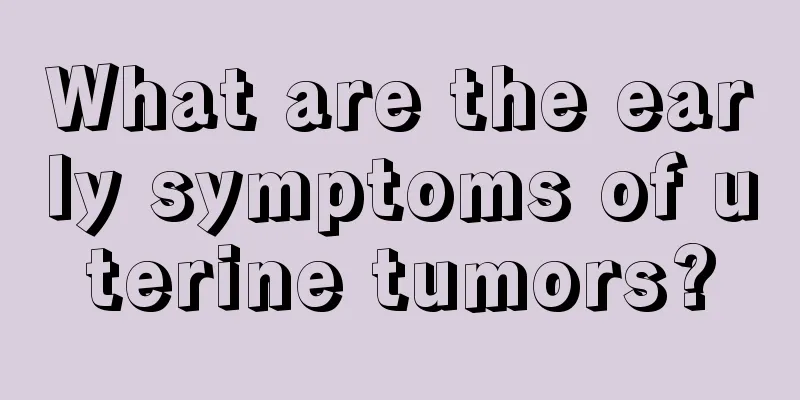What are the early symptoms of uterine tumors?

|
In life, for married people, the happiest thing is to have a child with the one they love. A child is the hope of a family, so every parent wants to have a baby. However, some diseases shatter people's hopes. Uterine tumor is one of them. Many female patients should identify the early symptoms and take early prevention measures. So what are the early symptoms of uterine tumors? Let’s take a look at them below. 1. Uterine bleeding: Uterine bleeding is the most common symptom of uterine fibroids. Clinically, it may manifest as menorrhagia, cyclical bleeding, increased menstrual volume, often accompanied by prolonged menstruation. This type of bleeding is the most common; frequent menstruation, shortened menstrual cycle, increased menstrual volume; irregular bleeding, loss of normal periodicity, long duration, sometimes more, sometimes less, and continuous bleeding, which is more common in submucosal myomas. Uterine bleeding is most common with submucosal fibroids and intermuscular fibroids, while subserosal fibroids rarely cause uterine bleeding. 2. Abdominal mass: The uterus is located deep in the pelvic cavity, and no mass can be felt in the abdomen when the fibroids first occur. 3. Vaginal discharge: Uterine submucosal fibroids or cervical submucosal fibroids can cause increased vaginal discharge. Once the tumor is infected, there may be a large amount of purulent leucorrhea. If there is ulceration, necrosis, and bleeding, there may be bloody or purulent vaginal discharge with a foul odor. 4. Compression symptoms: Uterine fibroids can cause compression symptoms on surrounding organs. If the anterior wall fibroids of the uterus are close to the bladder, bladder irritation symptoms may occur, such as frequent urination and urgency. 5. Pain: Generally, uterine fibroids do not cause pain symptoms. If pain symptoms occur, it is mostly caused by pathological changes in the fibroids themselves or combined with other pelvic diseases. 1) Pathological changes of uterine fibroids: Red degeneration of uterine fibroids is more common during pregnancy, manifested as acute abdominal pain in the lower abdomen, accompanied by vomiting, fever and local tenderness of the tumor; torsion of the pedicle of subserosal uterine fibroids, or giant subserosal uterine fibroids at the fundus of the uterus can cause uterine torsion in some cases, which can all cause acute abdominal pain; 2) Combined with other pelvic diseases: The most common are adenomyosis or endometriosis. The pain is characteristic, which is cyclical, progressive and gradually worsening dysmenorrhea, often accompanied by anal prolapse and dyspareunia rather than acute abdominal pain. 6. Infertility and miscarriage: Cervical fibroids may affect the entry of sperm into the uterine cavity; submucosal fibroids may hinder the implantation of fertilized eggs; giant primary uterine fibroids deform the uterine cavity, especially the interstitial part of the fallopian tube is squeezed by the fibroids and blocked, which hinders the passage of sperm; 7. Anemia: The main symptom of uterine fibroids is uterine bleeding. Long-term excessive menstruation or irregular bleeding can lead to hemorrhagic anemia. Clinically, there are anemia symptoms of varying degrees. Severe anemia is more common in submucosal fibroids. Severe anemia, especially for a long time, can cause myocardial nutritional disorders. 8. Polycythemia: It is rare for uterine fibroids to be accompanied by polycythemia. Most patients are asymptomatic, and the main basis for diagnosis is increased hemoglobin and red blood cell counts. No other cause of polycythemia can be found except uterine fibroids. After tumor resection, hemoglobin and red blood cells return to normal. 9. Hypoglycemia: Hypoglycemia associated with uterine fibroids is also rare. The main symptoms are low fasting blood sugar, loss of consciousness and even shock. The symptoms can completely disappear after glucose injection. The symptoms of hypoglycemia disappeared completely after tumor resection. After reading the above introduction to the early symptoms of uterine tumors, I think everyone should have some understanding. We must correctly understand the early symptoms of uterine tumors in order to prevent the disease and other complications in a timely manner. Most female patients should pay more attention to diet and rest, and treat various diseases early to avoid tragedies. |
<<: What kind of food should I eat to supplement my uterus?
>>: What are the symptoms of having no uterus?
Recommend
Is it normal for the tips of spider plant leaves to turn black? How to remedy the black tips of spider plant leaves?
As people's quality of life improves, more an...
Will low progesterone cause less menstruation?
Many women want to find out the question of "...
Is uterine maintenance really useful?
Nowadays, with the ever-accelerating pace of life...
What causes a fast heartbeat during pregnancy?
I believe that many expectant mothers during preg...
Can I fry sausages in an air fryer without thawing them? Why do sausages taste so good?
Grilled sausage is a kind of convenient food that...
What brand of underwear is good for sagging breasts?
The normal development time of breasts is during ...
What are the breast enhancement techniques?
Every woman hopes to have a plump chest. Having p...
Why do I still not have my period after taking progesterone?
Some female friends become anxious after taking c...
There is a small meat ball growing from the vagina to the mouth. It hurts.
If there are small lumps at the vulva, you should...
How to quickly eliminate spots during pregnancy
The main reason why pregnant women get spots is d...
What foods should not be eaten during cesarean section
Whether to choose a caesarean section is also an ...
After the operation, she felt as if she was lying in water, her whole body was icy cold.
Recently, an anesthesiologist from a large tertia...
Can pregnant women eat fried noodles and drink soup?
The diet of pregnant women is very important, bec...
What to do if pregnant women have moss
Pregnant women with ringworm usually need to do a...









